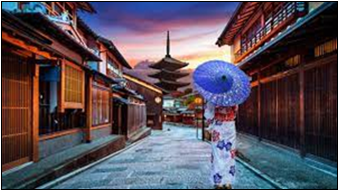
Speaker Review by Jan Reade
This month’s speaker for u3a was Jennifer Ichikawa. Jennifer is now living in Cleethorpes, after a very interesting life that included emigrating to New Zealand as a “£25 pom”. New Zealand is where she met her Japanese husband. Jennifer explained that her husband’s career took them to many places around the world, including Washington, USA, and of course his homeland – Japan.
The talk Jennifer gave, was all about the Kimono, the traditional Japanese garment and national dress of Japan. Kimono is worn by both men and women, but the talk concentrated on those worn by women.
We heard about the symbolism of the patterned fabrics, patterns which are seasonal, usually four are needed although careful choice of the fabric pattern can reduce this, which is just as well as these traditional garments can cost thousands of pounds.
We heard about the feudal roots of the kimono and the repression it brought to women, Jennifer told us – that many Japanese women hate it. The reasons for this became apparent when Jennifer demonstrated the many layers and complex construction of the garment necessary to wearing it. Wearing a kimono considerably restricts movement, which means when wearing one, for example, driving is impossible.
The whole ensemble has 3 layers the first two being plain white ‘body linens’ each having a top and skirt, that is meant to flatten the body shape, the second layer being of finer, better-quality fabric. The visible patterned outer layer is then added – all layers are folded left over right, very important! And all the layers are constructed from simple rectangles of fabric. The fold at the back of the neck is extremely significant – it must reveal the nape and back of the neck, and the hair must be pinned up to allow this.
The last layer is the Obi – a wide sash around the middle – this is 4 ½ metres long! At weddings the Obi is bought by the groom. There is a belt that ties on a small bustle at the back to support the Obi.
The final ensemble is full of symbolism, for example, a single lady, will have long sleeves on her kimono, once she is married they are cut short. There are many other features that have significance, such as “dot” details that denote family and status, and as the movement of the wearer also acquires ceremonial nuances, Jennifer told us that it would be very easy for her to make a faux pas when wearing a formal kimono, so to avoid this, she prefers to wear a simpler, traditional garment, the Yukata, a more casual or informal version of the kimono.
We were shown the footwear, designed to make feet appear small, the specially shaped divided toe socks – Tabi – which are usually white. Zori are the sandals are worn with a kimono for formal occasions. Ingeniously the zori sandal has a hidden “trapdoor” compartment beneath allowing access to replace the toe thong. Geta are raised wooden clogs that are worn with the informal yukata.
Jennifer told us, if you wear Kimono, probably you need a bag. There are rules for bags for formal occasions but you can choose freely for casual scenes, traditional bags are drawstring, a Kinchaku – is a traditional Japanese handbag.
What a wonderful insight into Japanese tradition and culture, very interesting and factual interspersed with personal experiences, Jennifer was thoroughly entertaining, whilst imparting her unique view of modern Japan. Thank you Jennifer!

Leave a Reply
You must be logged in to post a comment.